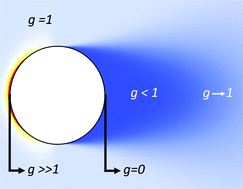Motility-induced inter-particle correlations and dynamics: a microscopic approach for active Brownian particles
Abstract
Amongst the theoretical approaches towards the dynamics and phase behaviour of suspensions of active Brownian particles (ABPs), no attempt has been made to specify the motility-induced inter-particle correlations as quantified by the pair-correlation function. Here, we derive expressions for the pair-correlation function for ABPs with very short-ranged direct interactions for small and large swimming velocities and low concentrations. The pair-correlation function is the solution of a differential equation that is obtained from the Fokker–Planck equation for the probability density function of the positions and orientations of the ABPs. For large swimming Peclet numbers, λ, the pair-correlation function is highly asymmetric. The pair-correlation function attains a large value, ∼λ, within a small region of spatial extent, ∼1/λ, near contact of the ABPs when the ABPs approach each other. The pair-correlation function is small within a large region of spatial extent, ∼λ1/3, when the ABPs move apart, with a contact value that is essentially zero. From the explicit expressions for the pair-correlation function, Fick's diffusion equation is generalized to include motility. It is shown that mass transport, in case of large swimming velocities, is dominated by a preferred swimming direction that is induced by concentration gradients. The expression for the pair-correlation function derived in this paper could serve as a starting point to obtain approximate results for high concentrations, which could then be employed in a first-principles analysis of the dynamics and phase behaviour of ABPs at higher concentrations.



 Please wait while we load your content...
Please wait while we load your content...